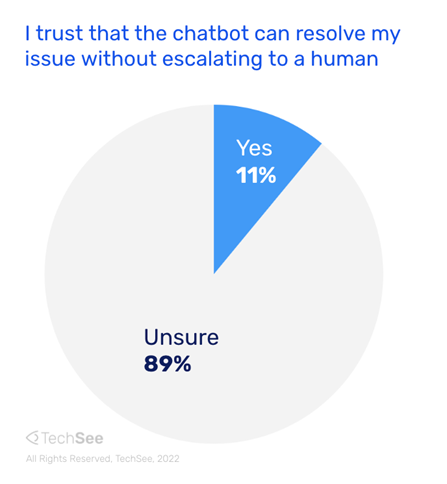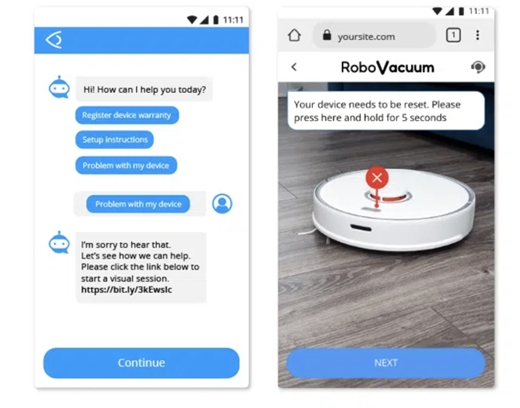Contents
The evolution of chatbots in customer service has generated much fanfare over the years. Chatbots promise a better customer experience by reducing wait times, delivering the digital experiences customers want, and providing 24/7 service on-demand. Furthermore, chatbots are cost savers, with the cost of a self-service interaction at just $0.10 compared to about $8 per live contact.
Though the benefits are proven, most customers have experienced enough frustrating chatbot experiences to generate a lack of trust. According to TechSee’s 2022 State of the Service Market Report, only 1 in 3 customers say they trust chatbots to provide satisfactory service. This lack of trust has detrimental effects on chatbot adoption and the overall impact on your customer satisfaction rates. But what can you do to improve customer trust and meet customer expectations? The following are 3 reasons customers say they don’t trust chatbots and how you can address these friction points to improve adoption and satisfaction.
#1: Chatbots Just Don’t Understand
Customers don’t feel that chatbots understand their issues. One of the key reasons for this is the lack of visual context. Customers have a hard time describing their problem in a way that chatbots will understand. When asked, more customers felt understood when using visuals compared with text and voice. However, nearly all chatbots today rely on the written word to interact with customers. This gap starts at the chatbot interaction and is perpetuated throughout the customer journey. Agents must work off textual descriptions and rely on audio interactions, creating further frustrations in understanding that continue even after the chatbot experience.
Add computer vision AI to chatbots to reduce friction points in issue identification. Allow customers to take photos or video of the problem. Computer vision AI to identify the issue. The chatbot can also prompt collection of images of key areas to help with identification of the issue by an agent.
#2: Chatbots Don’t Solve the Problem
A huge barrier in customer trust regarding chatbots is that customers feel chatbots can’t help them. A mere 11% feel confident that chatbots are able to help them resolve their inquiries. Customers feel frustrated when the chatbot session ends without a resolution. Though chatbot AI technology has greatly matured in the last few years, it still struggles to diagnose issues and or show customers how to solve them. Chatbots mostly rely on the descriptions from customers to diagnose the issue. They then must try to explain how to resolve an issue via text chat, or by linking to FAQ pages. For many customers, following written step-by-step instructions without visuals is a real challenge. For this reason, customers often use chatbots to connect with a human agent, rather than to resolve an issue (we’ll dive deeper into this in a moment).
They say a picture is worth a thousand words. Save your customers the time, and show them a picture of how to solve their issue.
But how can a bot visually show a customer how to resolve an issue without human assistance? The latest computer vision AI has progressed leaps and bounds. It is rapidly becoming a strategic technology in service automation. State-of-the-art, customized computer vision AI cannot only identify the problem, but also use AR annotations to guide the customer with step-by-step visual instructions to resolution. This has huge implications. 73% of customers report that they would be more open to using chatbots if they could diagnose their issue. The only question is, do you have the right computer vision technology?
#3: Chatbots are Routing Blindly, they Should be Sharing and Enhancing
60% of customers believe that chatbots are ONLY good for routing them to the correct agent. However, a whopping 95% of customers say they have to repeat themselves at least once. Information gathered during chatbot interactions is not being properly passed to the next step – be it an agent, workflow, or any other interaction. This gap in data transfer between chatbots and agents is causing friction in the customer experience. Customers do not want to have to repeat themselves. They expect to pick up where they left off from one interaction to the next.
There is an opportunity here to better meet customer expectations. When a customer asks for an escalation, use chatbots to collect information that can accelerate your support calls. Collecting images of their problem and applying computer vision AI will provide you with a wealth of information. For example, the AI can identify the specific make and model of the device (ensuring the right agent is assigned to the case), visually troubleshoot the setup, identify issues and suggest potential resolutions to the agent – all before the agent even begins their interaction. With this background, agents can better support customers, offering faster resolutions and truly personalized service.
An end-to-end data flow is critical to delivering a continuous service experience, and satisfactory resolution to every customer, every time. Use visual insight and apply visual intelligence across every interaction to improve your performance across every touchpoint.
Conclusion
Intelligent visual engagement removes much of the friction from the support chatbot experience. By further creating a continuous end-to-end flow, with visual data transfer, and computer vision AI to supplement agent assistance, you can improve the effectiveness and efficiency of chatbots, while reducing operations overhead.








